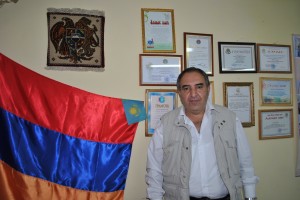 ASTANA – Hard work, dedication and entrepreneurial spirit, these are the qualities represented by the three colours of the Armenian flag. Red stands for the Armenian highland, its people’s continued struggle for survival and their maintenance of Christianity, independence and freedom. Blue symbolises the will of the Armenian people to live beneath peaceful skies. Orange marks Armenians’ creativity and hard-working nature.
ASTANA – Hard work, dedication and entrepreneurial spirit, these are the qualities represented by the three colours of the Armenian flag. Red stands for the Armenian highland, its people’s continued struggle for survival and their maintenance of Christianity, independence and freedom. Blue symbolises the will of the Armenian people to live beneath peaceful skies. Orange marks Armenians’ creativity and hard-working nature.
Today, Armenians live in small communities in over 70 countries, with the largest populations living in the U.S., Russia, France and Lebanon. The Armenian diaspora totals about eight million people. More than 25,000 Armenians live in Kazakhstan.
“In Yerevan [the capital of Armenia], there is an Institute of Ancient Manuscripts that archives ancient manuscripts from all over the world. Among these manuscripts there are scripts in the Kazakh language but using Armenian words,” Chairman of Astana’s Van Armenian Ethnocultural Centre Gagik Martirosyan told The Astana Times in an exclusive interview. “This proves that Kazakhs and Armenians had ties thousands of years ago,” he said.
Historical records show that Armenian warriors and traders once roamed freely in many parts of Central Asia, often fighting alongside local warlords in return for trading privileges. In more recent history, Armenians arrived in Kazakhstan in the 1860s, when the Russian Empire, which at the time controlled Armenian-populated areas in the North Caucasus, moved to explore the Kazakh steppes. Armenians accompanied them, acting as interpreters for the Russians as well as consultants and businessmen for the emerging oil industry.
Today, Armenians at the Van Centre are engaged in various industries in their adopted nation, Martirosyan said, mostly in construction and building.
“We have about 50 members in our ethnocultural centre who come from different working backgrounds. Our deputy is a doctor, there are retirees, some are businessmen, and whoever can help financially contributes to our centre, where our goals are to maintain fluency in our language. We teach the language to children … teach them to dance national dances, pay our dues to our ancestors and try to keep our traditions and history alive, and to proudly represent our nation,” Martirosyan explained.
The community all chips in to maintain the centre, the chairman says. The office is provided by a local ethnic Armenian businessman, for example. In addition, Martirosyan said, “the city akimat (local government) also allots funds to preserve our language and culture.” With so many local businesspeople involved in the centre, it has also become a site for networking.
According to Martirosyan, Kazakhstan’s favourable tax policy attracts many Armenians.
“In Kazakhstan, you pay your taxes and sleep in peace; you don’t have to worry about other things. The taxing policy also helped create the middle class and it grows stronger. The government relies on the middle class, as opposed to Armenia, for instance, [where] there is almost no middle class.”
Today, the Armenian economy, with a population of about three million, relies on the investment and support of Armenians abroad. In the Soviet era, the country’s economy was based largely on chemicals, electronics, machinery, processed food, synthetic rubber and textiles, but with the dissolution of the Armenian Soviet Republic, the economy collapsed.
Armenia’s economy has grown since 1995 and inflation has been negligible for the past several years. New sectors such as precious-stone processing and jewellery making, information and communication technology and even tourism are beginning to supplement more traditional sectors of the economy, like agriculture. The 1994 cease-fire in the Nagorno-Karabakh conflict has also helped boost the economy.
Armenians, like the country’s many other ethnic groups, are represented in the Assembly of the People of Kazakhstan (APK). The APK was established by President Nursultan Nazarbayev in 1995; in 2007, the President signed a decree giving the APK the right to contribute nine of its members to the Mazhilis (lower house of Parliament), a unique privilege for such an assembly.
“I would like to wish the [government] of Kazakhstan to continue the flexible and righteous policy towards all peoples. As our President says, our strength lies in the unity of all nations. All these nations that live in Kazakhstan contribute something to the development of the country. Today in Kazakhstan we can grow, build, continue developing, work, live – we have peaceful skies over our heads,” Martirosyan concluded.

